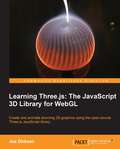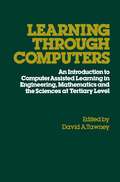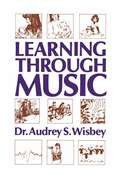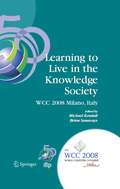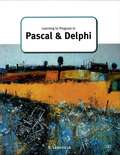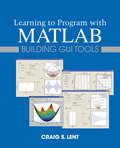- Table View
- List View
Learning Theory and Online Technologies
by Linda HarasimLearning Theory and Online Technologies offers a powerful overview of the current state of online learning, the foundations of its historical roots and growth, and a framework for distinguishing between the major approaches to online learning. It addresses pedagogy (how to design an effective online environment for learning), evaluation (how to know that students are learning), and history (how past research can guide successful online teaching and learning outcomes). An ideal textbook for undergraduate Education and Communication programs as well as Educational Technology Masters, Ph.D., and Certificate programs, Learning Theory and Online Technologies provides a synthesis of the key advances in online education learning theory and the key frameworks of research, and clearly links theory and research to successful learning practice. This revised second edition updates data on digital media adoption globally, adds a new chapter on connectivism as a learning theory, and updates the chapter on online collaborative learning, renaming the theory as collaborativism and considering the challenges that arise with the growth of artificial intelligence.
Learning Three.js – the JavaScript 3D Library for WebGL - Second Edition
by Jos DirksenIf you know JavaScript and want to start creating 3D graphics that run in any browser, this book is a great choice for you. You don't need to know anything about math or WebGL; all that you need is general knowledge of JavaScript and HTML.
Learning Three.js: The Javascript 3d Library For Webgl
by Jos Dirksen“Learning Three.js is a hands-on guide which provides everything you need to start working with the powerful JavaScript library, and start creating awesome in-browser visualizations”.Learning Three.js is written for anyone looking to get started with Three.js, or looking to improve their skills with the popular js library. The book assumes some knowledge of javascript, but you don't need any knowledge of Three.js itself to follow the book.
Learning Through Computers: An Introduction to Computer Assisted Learning in Engineering, Mathematics and the Sciences at Tertiary Level
by D. TawneyLearning Through Knowledge Management
by Pervaiz K. Ahmed Kwang Kok Lim Ann Y Loh'Learning through Knowledge Management' provides an insightful overview of the main issues integrating learning and Knowledge Management. It offers a rich resource of case examples that highlight Knowledge Management in practice. The text explores and defines learning and Knowledge Management concepts, and deals with the elements that play an important part in determining implementation success in the organization. The chapters present a managerially oriented discussion of the following key areas:* The role of processes in managing knowledge* The behavioural side of Knowledge Management * Leadership reflexes for knowledge management success* The key features of Information Technology required for Knowledge Management* The future of Knowledge Management as part of organization management.There are many case studies which include: British Airways BP Amoco Ford Hewlett Packard Xerox Swedish Police IBM The case studies encompass a diverse and broad range of sectors, maturity of practice, problems and approaches to Knowledge Management.
Learning Through Knowledge Management
by Pervaiz K. Ahmed Kwang Kok Lim Ann Y Loh'Learning through Knowledge Management' provides an insightful overview of the main issues integrating learning and Knowledge Management. It offers a rich resource of case examples that highlight Knowledge Management in practice. The text explores and defines learning and Knowledge Management concepts, and deals with the elements that play an important part in determining implementation success in the organization. The chapters present a managerially oriented discussion of the following key areas:* The role of processes in managing knowledge* The behavioural side of Knowledge Management * Leadership reflexes for knowledge management success* The key features of Information Technology required for Knowledge Management* The future of Knowledge Management as part of organization management.There are many case studies which include: British Airways BP Amoco Ford Hewlett Packard Xerox Swedish Police IBM The case studies encompass a diverse and broad range of sectors, maturity of practice, problems and approaches to Knowledge Management.
Learning-Through-Touring: Mobilising Learners And Touring Technologies To Creatively Explore The Built Environment (Technology Enhanced Learning #6)
by Juliet SprakeLearning-through-Touring uncovers ways in which people interact with the built environment by exploring the spaces around, between and within buildings. The key idea embodied in the book is that learning through touring is haptic –the learner is a physical, cognitive and emotional participant in the process. It also develops the concept that tours, rather than being finished products, are designed to evolve through user participation and over time. Part One of the book presents a series of analytical investigations into theories and practices of learning and touring that have then been developed to produce a set of conceptual methods for tour design. Projects that have tried and tested these methods are described in Part Two. Technologies that have been utilised as portable tools for learning-through-touring are illustrated both through historical and contemporary practices. In all of this, there is an underlying belief that what is formally presented to us by ‘authorities’ is open to self-discovery, questioning and independent enquiry. The book is particularly relevant for those seeking innovative ways to explore and engage with the built environment; mobile learning educators; learning departments in museums, galleries and historic buildings; organisations involved in ‘bridging the gap’ between architecture and public understanding and anyone who enjoys finding out new things about their environment.
Learning to Classify Text Using Support Vector Machines (The Springer International Series in Engineering and Computer Science #668)
by Thorsten JoachimsBased on ideas from Support Vector Machines (SVMs), Learning To Classify Text Using Support Vector Machines presents a new approach to generating text classifiers from examples. The approach combines high performance and efficiency with theoretical understanding and improved robustness. In particular, it is highly effective without greedy heuristic components. The SVM approach is computationally efficient in training and classification, and it comes with a learning theory that can guide real-world applications. Learning To Classify Text Using Support Vector Machines gives a complete and detailed description of the SVM approach to learning text classifiers, including training algorithms, transductive text classification, efficient performance estimation, and a statistical learning model of text classification. In addition, it includes an overview of the field of text classification, making it self-contained even for newcomers to the field. This book gives a concise introduction to SVMs for pattern recognition, and it includes a detailed description of how to formulate text-classification tasks for machine learning.
Learning to Learn
by Sebastian Thrun Lorien PrattOver the past three decades or so, research on machine learning and data mining has led to a wide variety of algorithms that learn general functions from experience. As machine learning is maturing, it has begun to make the successful transition from academic research to various practical applications. Generic techniques such as decision trees and artificial neural networks, for example, are now being used in various commercial and industrial applications. Learning to Learn is an exciting new research direction within machine learning. Similar to traditional machine-learning algorithms, the methods described in Learning to Learn induce general functions from experience. However, the book investigates algorithms that can change the way they generalize, i.e., practice the task of learning itself, and improve on it. To illustrate the utility of learning to learn, it is worthwhile comparing machine learning with human learning. Humans encounter a continual stream of learning tasks. They do not just learn concepts or motor skills, they also learn bias, i.e., they learn how to generalize. As a result, humans are often able to generalize correctly from extremely few examples - often just a single example suffices to teach us a new thing. A deeper understanding of computer programs that improve their ability to learn can have a large practical impact on the field of machine learning and beyond. In recent years, the field has made significant progress towards a theory of learning to learn along with practical new algorithms, some of which led to impressive results in real-world applications. Learning to Learn provides a survey of some of the most exciting new research approaches, written by leading researchers in the field. Its objective is to investigate the utility and feasibility of computer programs that can learn how to learn, both from a practical and a theoretical point of view.
Learning to Live in the Knowledge Society: IFIP 20th World Computer Congress, IFIP TC 3 ED-L2L Conference, September 7-10, 2008, Milano, Italy (IFIP Advances in Information and Communication Technology #Vol. 173)
by Michael Kendall Brian SamwaysED-L2L, Learning to Live in the Knowledge Society, is one of the co-located conferences of the 20th World Computer Congress (WCC2008). The event is organized under the auspices of IFIP (International Federation for Information Processing) and is to be held in Milan from 7th to 10th September 2008. ED-L2L is devoted to themes related to ICT for education in the knowledge society. It provides an international forum for professionals from all continents to discuss research and practice in ICT and education. The event brings together educators, researchers, policy makers, curriculum designers, teacher educators, members of academia, teachers and content producers. ED-L2L is organised by the IFIP Technical Committee 3, Education, with the support of the Institute for Educational Technology, part of the National Research Council of Italy. The Institute is devoted to the study of educational innovation brought about through the use of ICT. Submissions to ED-L2L are published in this conference book. The published papers are devoted to the published conference themes: Developing digital literacy for the knowledge society: information problem solving, creating, capturing and transferring knowledge, commitment to lifelong learning Teaching and learning in the knowledge society, playful and fun learning at home and in the school New models, processes and systems for formal and informal learning environments and organisations Developing a collective intelligence, learning together and sharing knowledge ICT issues in education - ethics, equality, inclusion and parental role Educating ICT professionals for the global knowledge society Managing the transition to the knowledge society
Learning to Play: Reinforcement Learning and Games
by Aske PlaatIn this textbook the author takes as inspiration recent breakthroughs in game playing to explain how and why deep reinforcement learning works. In particular he shows why two-person games of tactics and strategy fascinate scientists, programmers, and game enthusiasts and unite them in a common goal: to create artificial intelligence (AI). After an introduction to the core concepts, environment, and communities of intelligence and games, the book is organized into chapters on reinforcement learning, heuristic planning, adaptive sampling, function approximation, and self-play. The author takes a hands-on approach throughout, with Python code examples and exercises that help the reader understand how AI learns to play. He also supports the main text with detailed pointers to online machine learning frameworks, technical details for AlphaGo, notes on how to play and program Go and chess, and a comprehensive bibliography.The content is class-tested and suitable for advanced undergraduate and graduate courses on artificial intelligence and games. It's also appropriate for self-study by professionals engaged with applications of machine learning and with games development. Finally it's valuable for any reader engaged with the philosophical implications of artificial and general intelligence, games represent a modern Turing test of the power and limitations of AI.
Learning to Program in Pascal and Delphi (PDF)
by S. LangfieldThis book is designed to help students on the AQA 'AS' Level Computing course to learn the programming covered in Unit 1, and to enable the Unit 3 Practical Exercise to be tackled using either Pascal or Delphi.
Learning To Program In Python (PDF)
by P. M. HeathcoteThis book is a straightforward guide to the Python programming language and programming techniques. It covers all of the practical programming skills that may be required up to GCSE level and for those at AS Level with limited exposure to Python. It is suitable for both experienced programmers, students or individuals with very little or no programming experience in other languages. It teaches basic syntax and programming techniques, and introduces three inbuilt Python modules: Tkinter, used for building a graphical user interface, which is an option that some users may like to include in their project work. SQLite, which enables the creation and processing of a database from within a Python program. This provides an alternative to writing to a text file when data needs to be stored and retrieved. pdb, Python’s debugging module, which can be used to help find elusive logic errors.
Learning to Program in Visual Basic (PDF)
by Sylvia LangfieldThis book is a straightforward guide to the Visual Basic programming language and programming techniques. It covers all of the practical programming skills that may be required up to GCSE level and for those at AS Level with limited exposure to VB. It is suitable for both experienced programmers, students or individuals with very little or no programming experience in other languages.
Learning to Program the Object-oriented Way with C#
by Vinny Cahill Donal LaffertyC# is a modern, object-oriented language that enables programmers to quickly build a wide range of applications for the new Microsoft .NET platform, which provides tools and services that fully exploit both computing and communications. Learning to Program the Object-Oriented Way with C# presents an introductory guide to this hot topic. The authors use a practice-based approach supported by lots of examples of increasing complexity and frequent graded exercises, which are available online. -Introduces an approach to learning programming based on the use of object orientation from day one. -Includes many worked examples, the code and solution to which are available online. -The book is being technically reviewed and approved by Microsoft. -One of the first introductory textbooks on C# and object orientation - based on the final release version at the beginning of 2002. -Suitable for courses in introductory programming.
Learning to Program with MATLAB: Building GUI Tools
by Craig S. LentAuthor Craig Lent’s 1st edition of Learning to Program with MATLAB: Building GUI Tools teaches the core concepts of computer programming, such as arrays, loops, function, basic data structures, etc., using MATLAB. The text has a focus on the fundamentals of programming and builds up to an emphasis on GUI tools, covering text-based programs first, then programs that produce graphics. This creates a visual expression of the underlying mathematics of a problem or design.
Learning to Program with MATLAB: Building GUI Tools
by Craig S. LentLearning to Program with MATLAB Introductory text integrating science, mathematics, and engineering to give a basic understanding of the fundamentals of computer programming with MATLAB Learning to Program with MATLAB: Building GUI Tools, Second Edition serves as a compact introduction to computer programming using the MATLAB language, covering elements of both program and graphical user interface (GUI) design to enable readers to create computer programs just like the ones they are accustomed to interacting with. Rather than being encyclopedic in scope, the goal of the text is to describe what users will find most useful and point to other features. Descriptions and examples of some of the most useful functions are included throughout, particularly with regards to engineering and science applications. The work also includes updated videos and problem solutions on an instructor companion website. The first edition of Learning to Program with MATLAB employed the MATLAB graphical user interface design environment (GUIDE) to develop the GUI tools. The second edition is based on the new and improved App Designer program, which has supplanted GUIDE. This edition includes: Core concepts of computer programming using MATLAB, such as arrays, loops, functions, and basic data structures How to write your own MATLAB functions, covering topics such as local workspaces, multiple outputs, function files, and other functional forms The new string class and table class, some new features of function arguments, and re-written sections for building GUI tools with App Designer Syntax for graphics and App Designer features, plus examples demonstrating the new way to handle string information Starting with the basics and building up to an emphasis on GUI tools, Learning to Program with MATLAB is a comprehensive introduction to programming in a robust and multipurpose language, making it an ideal classroom resource for both students and instructors in related programs of study.
Learning to Program with MATLAB: Building GUI Tools
by Craig S. LentLearning to Program with MATLAB Introductory text integrating science, mathematics, and engineering to give a basic understanding of the fundamentals of computer programming with MATLAB Learning to Program with MATLAB: Building GUI Tools, Second Edition serves as a compact introduction to computer programming using the MATLAB language, covering elements of both program and graphical user interface (GUI) design to enable readers to create computer programs just like the ones they are accustomed to interacting with. Rather than being encyclopedic in scope, the goal of the text is to describe what users will find most useful and point to other features. Descriptions and examples of some of the most useful functions are included throughout, particularly with regards to engineering and science applications. The work also includes updated videos and problem solutions on an instructor companion website. The first edition of Learning to Program with MATLAB employed the MATLAB graphical user interface design environment (GUIDE) to develop the GUI tools. The second edition is based on the new and improved App Designer program, which has supplanted GUIDE. This edition includes: Core concepts of computer programming using MATLAB, such as arrays, loops, functions, and basic data structures How to write your own MATLAB functions, covering topics such as local workspaces, multiple outputs, function files, and other functional forms The new string class and table class, some new features of function arguments, and re-written sections for building GUI tools with App Designer Syntax for graphics and App Designer features, plus examples demonstrating the new way to handle string information Starting with the basics and building up to an emphasis on GUI tools, Learning to Program with MATLAB is a comprehensive introduction to programming in a robust and multipurpose language, making it an ideal classroom resource for both students and instructors in related programs of study.
Learning to Quantify (The Information Retrieval Series #47)
by Andrea Esuli Alessandro Fabris Alejandro Moreo Fabrizio SebastianiThis open access book provides an introduction and an overview of learning to quantify (a.k.a. “quantification”), i.e. the task of training estimators of class proportions in unlabeled data by means of supervised learning. In data science, learning to quantify is a task of its own related to classification yet different from it, since estimating class proportions by simply classifying all data and counting the labels assigned by the classifier is known to often return inaccurate (“biased”) class proportion estimates. The book introduces learning to quantify by looking at the supervised learning methods that can be used to perform it, at the evaluation measures and evaluation protocols that should be used for evaluating the quality of the returned predictions, at the numerous fields of human activity in which the use of quantification techniques may provide improved results with respect to the naive use of classification techniques, and at advanced topics in quantification research. The book is suitable to researchers, data scientists, or PhD students, who want to come up to speed with the state of the art in learning to quantify, but also to researchers wishing to apply data science technologies to fields of human activity (e.g., the social sciences, political science, epidemiology, market research) which focus on aggregate (“macro”) data rather than on individual (“micro”) data.
Learning to Rank for Information Retrieval
by Tie-Yan LiuDue to the fast growth of the Web and the difficulties in finding desired information, efficient and effective information retrieval systems have become more important than ever, and the search engine has become an essential tool for many people. The ranker, a central component in every search engine, is responsible for the matching between processed queries and indexed documents. Because of its central role, great attention has been paid to the research and development of ranking technologies. In addition, ranking is also pivotal for many other information retrieval applications, such as collaborative filtering, definition ranking, question answering, multimedia retrieval, text summarization, and online advertisement. Leveraging machine learning technologies in the ranking process has led to innovative and more effective ranking models, and eventually to a completely new research area called “learning to rank”. Liu first gives a comprehensive review of the major approaches to learning to rank. For each approach he presents the basic framework, with example algorithms, and he discusses its advantages and disadvantages. He continues with some recent advances in learning to rank that cannot be simply categorized into the three major approaches – these include relational ranking, query-dependent ranking, transfer ranking, and semisupervised ranking. His presentation is completed by several examples that apply these technologies to solve real information retrieval problems, and by theoretical discussions on guarantees for ranking performance. This book is written for researchers and graduate students in both information retrieval and machine learning. They will find here the only comprehensive description of the state of the art in a field that has driven the recent advances in search engine development.
Learning to Rank for Information Retrieval and Natural Language Processing (Synthesis Lectures on Human Language Technologies)
by Hang LiLearning to rank refers to machine learning techniques for training the model in a ranking task. Learning to rank is useful for many applications in information retrieval, natural language processing, and data mining. Intensive studies have been conducted on the problem recently and significant progress has been made. This lecture gives an introduction to the area including the fundamental problems, existing approaches, theories, applications, and future work. The author begins by showing that various ranking problems in information retrieval and natural language processing can be formalized as two basic ranking tasks, namely ranking creation (or simply ranking) and ranking aggregation. In ranking creation, given a request, one wants to generate a ranking list of offerings based on the features derived from the request and the offerings. In ranking aggregation, given a request, as well as a number of ranking lists of offerings, one wants to generate a new ranking list of the offerings. Ranking creation (or ranking) is the major problem in learning to rank. It is usually formalized as a supervised learning task. The author gives detailed explanations on learning for ranking creation and ranking aggregation, including training and testing, evaluation, feature creation, and major approaches. Many methods have been proposed for ranking creation. The methods can be categorized as the pointwise, pairwise, and listwise approaches according to the loss functions they employ. They can also be categorized according to the techniques they employ, such as the SVM based, Boosting SVM, Neural Network based approaches. The author also introduces some popular learning to rank methods in details. These include PRank, OC SVM, Ranking SVM, IR SVM, GBRank, RankNet, LambdaRank, ListNet & ListMLE, AdaRank, SVM MAP, SoftRank, Borda Count, Markov Chain, and CRanking. The author explains several example applications of learning to rank including web search, collaborative filtering, definition search, keyphrase extraction, query dependent summarization, and re-ranking in machine translation. A formulation of learning for ranking creation is given in the statistical learning framework. Ongoing and future research directions for learning to rank are also discussed. Table of Contents: Introduction / Learning for Ranking Creation / Learning for Ranking Aggregation / Methods of Learning to Rank / Applications of Learning to Rank / Theory of Learning to Rank / Ongoing and Future Work
Learning to Rank for Information Retrieval and Natural Language Processing, Second Edition (Synthesis Lectures on Human Language Technologies)
by Hang LiLearning to rank refers to machine learning techniques for training a model in a ranking task. Learning to rank is useful for many applications in information retrieval, natural language processing, and data mining. Intensive studies have been conducted on its problems recently, and significant progress has been made. This lecture gives an introduction to the area including the fundamental problems, major approaches, theories, applications, and future work. The author begins by showing that various ranking problems in information retrieval and natural language processing can be formalized as two basic ranking tasks, namely ranking creation (or simply ranking) and ranking aggregation. In ranking creation, given a request, one wants to generate a ranking list of offerings based on the features derived from the request and the offerings. In ranking aggregation, given a request, as well as a number of ranking lists of offerings, one wants to generate a new ranking list of the offerings. Ranking creation (or ranking) is the major problem in learning to rank. It is usually formalized as a supervised learning task. The author gives detailed explanations on learning for ranking creation and ranking aggregation, including training and testing, evaluation, feature creation, and major approaches. Many methods have been proposed for ranking creation. The methods can be categorized as the pointwise, pairwise, and listwise approaches according to the loss functions they employ. They can also be categorized according to the techniques they employ, such as the SVM based, Boosting based, and Neural Network based approaches. The author also introduces some popular learning to rank methods in details. These include: PRank, OC SVM, McRank, Ranking SVM, IR SVM, GBRank, RankNet, ListNet & ListMLE, AdaRank, SVM MAP, SoftRank, LambdaRank, LambdaMART, Borda Count, Markov Chain, and CRanking. The author explains several example applications of learning to rank including web search, collaborative filtering, definition search, keyphrase extraction, query dependent summarization, and re-ranking in machine translation. A formulation of learning for ranking creation is given in the statistical learning framework. Ongoing and future research directions for learning to rank are also discussed. Table of Contents: Learning to Rank / Learning for Ranking Creation / Learning for Ranking Aggregation / Methods of Learning to Rank / Applications of Learning to Rank / Theory of Learning to Rank / Ongoing and Future Work
Learning to Solve Complex Scientific Problems
by David H. JonassenProblem solving is implicit in the very nature of all science, and virtually all scientists are hired, retained, and rewarded for solving problems. Although the need for skilled problem solvers has never been greater, there is a growing disconnect between the need for problem solvers and the educational capacity to prepare them. Learning to Solve Complex Scientific Problems is an immensely useful read offering the insights of cognitive scientists, engineers and science educators who explain methods for helping students solve the complexities of everyday, scientific problems. Important features of this volume include discussions on:*how problems are represented by the problem solvers and how perception, attention, memory, and various forms of reasoning impact the management of information and the search for solutions;*how academics have applied lessons from cognitive science to better prepare students to solve complex scientific problems;*gender issues in science and engineering classrooms; and*questions to guide future problem-solving research. The innovative methods explored in this practical volume will be of significant value to science and engineering educators and researchers, as well as to instructional designers.
Learning to Solve Complex Scientific Problems
by David H. JonassenProblem solving is implicit in the very nature of all science, and virtually all scientists are hired, retained, and rewarded for solving problems. Although the need for skilled problem solvers has never been greater, there is a growing disconnect between the need for problem solvers and the educational capacity to prepare them. Learning to Solve Complex Scientific Problems is an immensely useful read offering the insights of cognitive scientists, engineers and science educators who explain methods for helping students solve the complexities of everyday, scientific problems. Important features of this volume include discussions on:*how problems are represented by the problem solvers and how perception, attention, memory, and various forms of reasoning impact the management of information and the search for solutions;*how academics have applied lessons from cognitive science to better prepare students to solve complex scientific problems;*gender issues in science and engineering classrooms; and*questions to guide future problem-solving research. The innovative methods explored in this practical volume will be of significant value to science and engineering educators and researchers, as well as to instructional designers.


